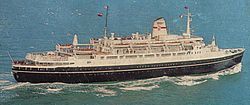Stefan Batory (ship)
|
||||||||||||||||||||||
|
||||||||||||||||||||||
|
||||||||||||||||||||||
|
||||||||||||||||||||||
|
||||||||||||||||||||||
The turbine ship Stefan Batory was a Polish passenger ship.
history
The ship was built as the second of two sister ships (the other was the Ryndam ) under the hull number 733 at the Dutch shipyard Wilton-Fijenoord for the Holland-America Line . Initially it was planned to build combined freighters . However, Holland-America Line changed the order during construction.
The ship, which as Diemerdijk was scheduled to run on 5 April 1952 by the stack . It was used by Holland-America Line as a Maasdam on the Rotterdam - Montreal - New York route. At times it was also used for cruises . On the Canada route, however, it made losses due to low utilization.
In May 1968, the ship was acquired by Polskie Linie Oceaniczne for three million US dollars in order to continue the tradition of its predecessor, Batory , which was decommissioned in the same year . After minor modifications at the Gdańsk repair yard (a second conversion phase took place in the winter of 1979/70), the ship initially offered space for 805 passengers. Two loading hatches were converted into a cinema or crew quarters and a pool; a sports hall and a sauna were installed. After the reconstruction, the measurement was 15,044 GRT, the displacement was 7,170 tons, after further reconstruction 6,489 tons.

On April 11, 1969, the Stefan Batory took up the liner service from Poland via Copenhagen and Tilbury to Québec and Montreal in Canada, because like its predecessor, it was refused entry into New York. On this route she competed u. a. with the Empress of Canada and the Aleksandr Pushkin .
The very popular with the large ethnic Polish population in North America and busy 92 to 93 percent ship visited by the end of 1951 lasting until 1970 boycott by American ports in January 1971 for the first time New York and excited because of the just ended Polish shipyard workers uprising in December 1970 a Scandal. Since 1971 it has been used on cruises to the Caribbean, the Canary Islands, Norway and the Black Sea; In 1972 the Stefan Batory visited German ports for the first time with Cuxhaven and Hamburg . Time and again Poles left the ship without permission to leave for Western Europe, for example 81 people in Hamburg in 1971 and 192 people in 1984.
The ship made up for the lack of comfort - lack of bathing facilities in the cabins - with its atmosphere, violin concerts, good food and low travel tariffs.
In 1987 the liner service to Montreal, which ran via Rotterdam since 1977 , a. a. because of the stricter environmental legislation in Canada, which would have made renovations necessary. In April 1988 the ship was sold under the name Stefan to a Greek shipowner in Piraeus and from there in 1989 to Stena Line in Sweden. It has been a hotel ship for refugees in Gothenburg since 1991 , now measured at 11,693 GRT. There it also served as a film set. In 1991 the ship went to Piraeus in Greece as a hotel ship. After renovation plans failed, it was a ship reserve in Chalkis , stranded in a storm in 1997 and was scrapped in Aliağa in Turkey in 2000 .
Technical data and equipment
The ship, planned as a freighter, was equipped with two Foster Wheeler steam boilers with a steam pressure of 32.7 atm and a capacity of 50 tons per hour, each of which supplied a high and low pressure turbine from General Electric with a two-speed gearbox with steam. Maximum and cruising speed were 18 and 16 knots, respectively, and the range was 12,200 nautical miles.
The ship had two classes of passengers. There was space for around 40 passengers in first class and around 850 in second class. In 1961 the ship was rebuilt. The passenger capacity was slightly reduced. Due to the modifications in 1968 and 1970, it was further reduced to 779.
literature
- Arnold Kludas: The world's great passenger ships. A documentation. Volume V: 1950–1974 , Stalling Verlag; Oldenburg, Hamburg 1974, ISBN 3-7979-1844-5 , p. 38.
Web links
Individual evidence
- ↑ a b T / S MAASDAM , Facta om Fartyg. Retrieved November 13, 2015.
- ^ Allan E. Jordan: Hail & Farewell To The Classic Liner. In: Cruise Travel , February 2000.
- ^ Marek Twardowski: Stefan Batory. JSC Mkroflota No. 89, 2006. ISSN 1508-5449 .
- ↑ According to the pl.wikipedia.org 10,300 nautical miles.
- ↑ a b TSS Rijndam / TSS Maasdam ssmaritime.com. Retrieved November 13, 2015.
- ↑ According to information from pl.wikipedia.org on 783. The information on the distribution between 1st and 2nd class is slightly inconsistent in the sources.
